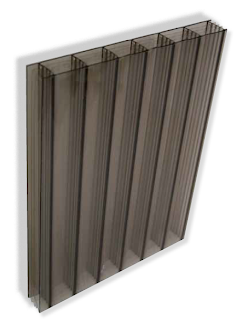The Polycarbonate sheets shown here are refered to as Twin Wall and 5 Wall. They are extremely strong and UV protected, and often used for greenhouse glazing.
While I have seen polycarbonate used as a collector's glazing I have not been able to find an example of this type of material used as the conduit for a thermal solar absorber.
This light weight material would appear to be near to perfect for this application if placed in an insulated box with a black background. An extra layer of glazing may not even be necessary.
The area would be well utilized with water passages, and at $57.00 for a 4x8 sheet the price is reasonable.
A manifold could be created by cutting back the inner walls by about 1/2 " and then sealing the end with an end cap. A PVC quick connect could then be inserted into the side of the end cap for the plumbing.
The melting temperature of extruded polystyrene is 240F well above the maximum temperature I would expect.
2" of extruded polystyrene would offer an R-Value of about 10.
For a 4' x 8' collector the polycarbonate should weigh about 18 lbs. and 2" of extruded polystyrene about 6 lbs. A wood case is going to be the heaviest part of the panel. A 4x8 sheet of 1/2" plywood weighs about 48 lbs. and 24' of 1x4 pine weighs about 24 lbs. for a total of 18+6+48+24=96 lbs. 72 lbs coming directly from the case.
If a case were made of aluminum sheet metal, I expect it would weigh about 25 lbs less and it would look more professional. Since I often work alone I'm always thinking of weight.
Update 2012.01.22:
I found a some information about experiments using "Black Liquid Collectors" first built by Minardi and Chuang in 1975 which used a heat transfer liquid consisting of 3 parts Prestone II, 2 parts water and 3 grams India ink per liter. The liquid was translucent, but it absorbed 98% of the incident solar radiation withing the first 1/4".
Minardi and Chuang performed further experimentation with tube spacing and and various additives. Graphite was found to be the most absorbent. It was also found that when the tubes were spaced one diameter apart the efficiency improved. This is thought to be due to the greater angular collection area and the collectors ability to collect scattered light. Similar results have been noted with Evacuated Heat Tubes.
Twin wall polycarbonate may not have the advantage of increased angular collection area, but the simplicity and cost of this system still makes it an attractive option which I look forward to using.





Hello, can you tell me what solution you created for the solarcolector?
ReplyDeleteI have had too many sticks in the fire and never built this. My feeling is that it would tend to clog and leak. Sometimes I just brain storm and never get it done.
ReplyDeleteIf you are looking for heat, I would look into Rocket Mass Stoves. Here's a link http://chicoaquaponic.blogspot.com/2012/12/rocket-mass-stove.html